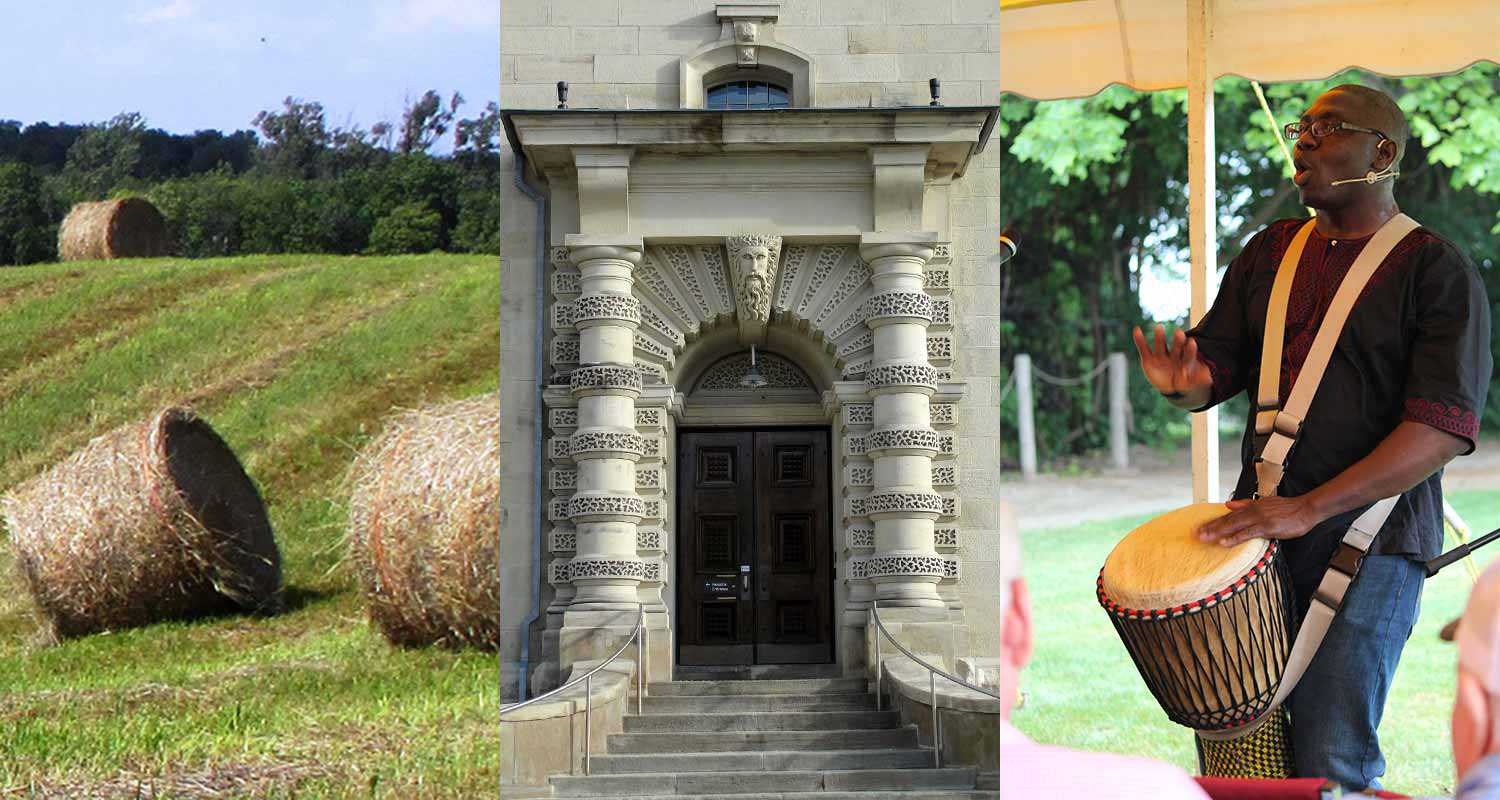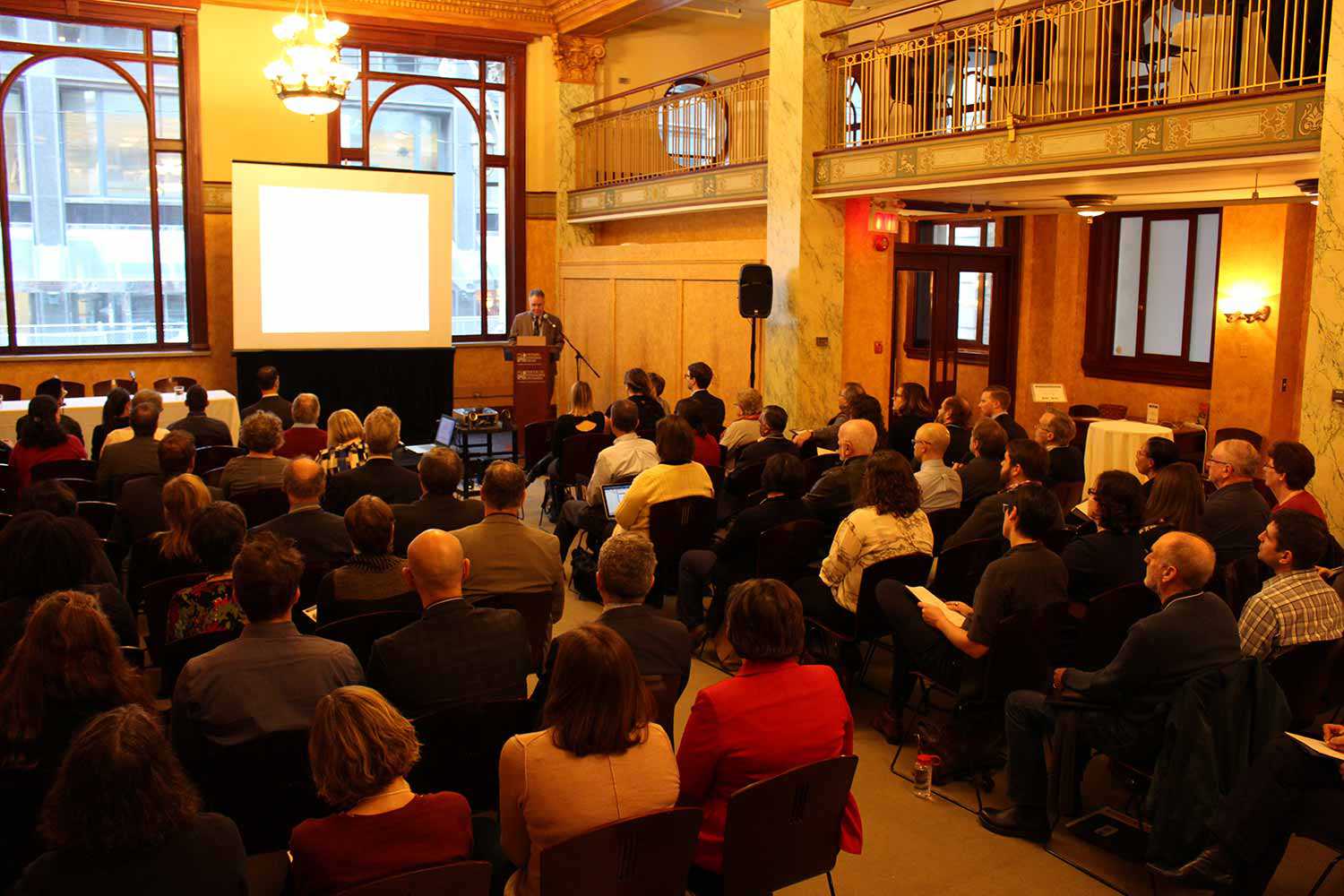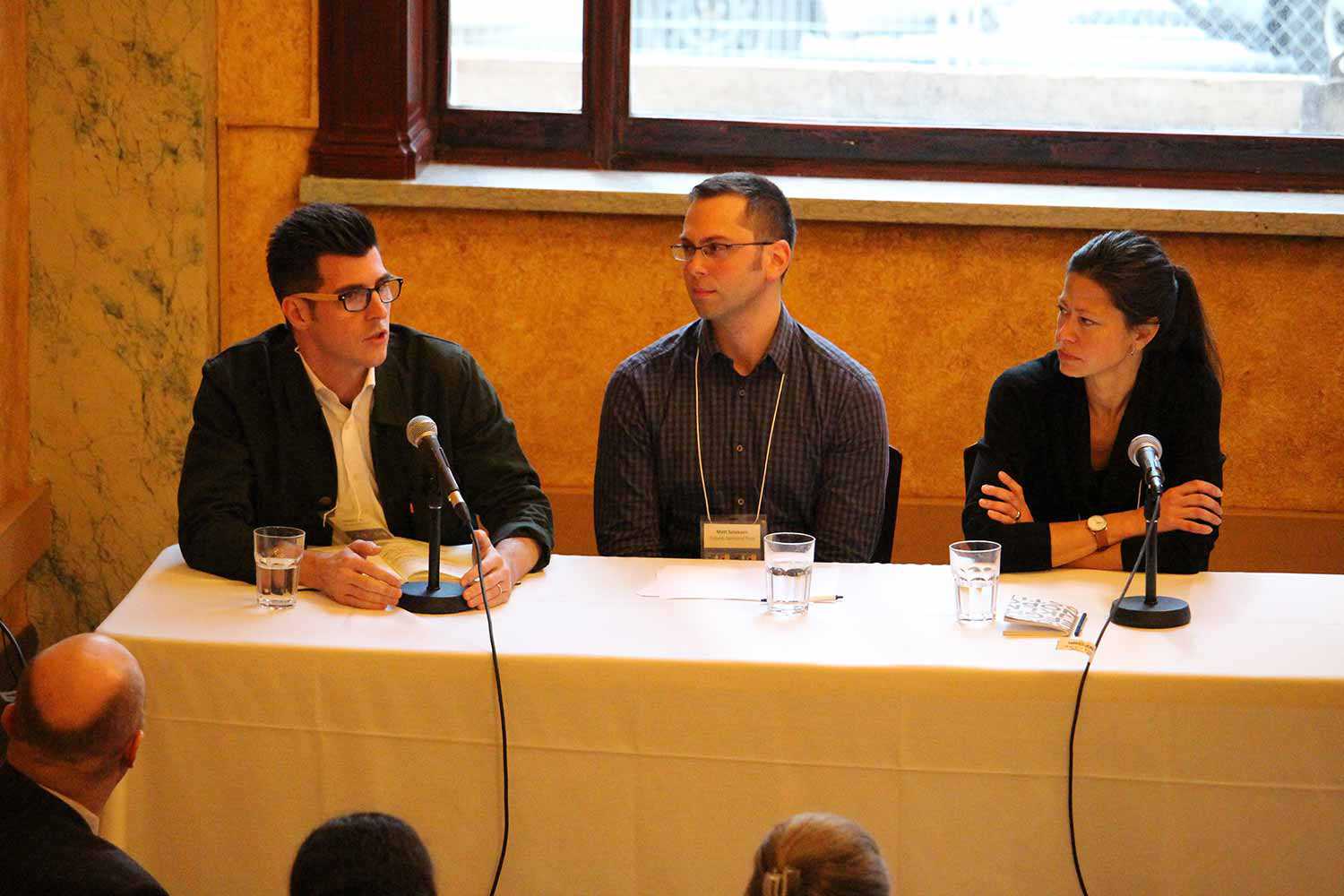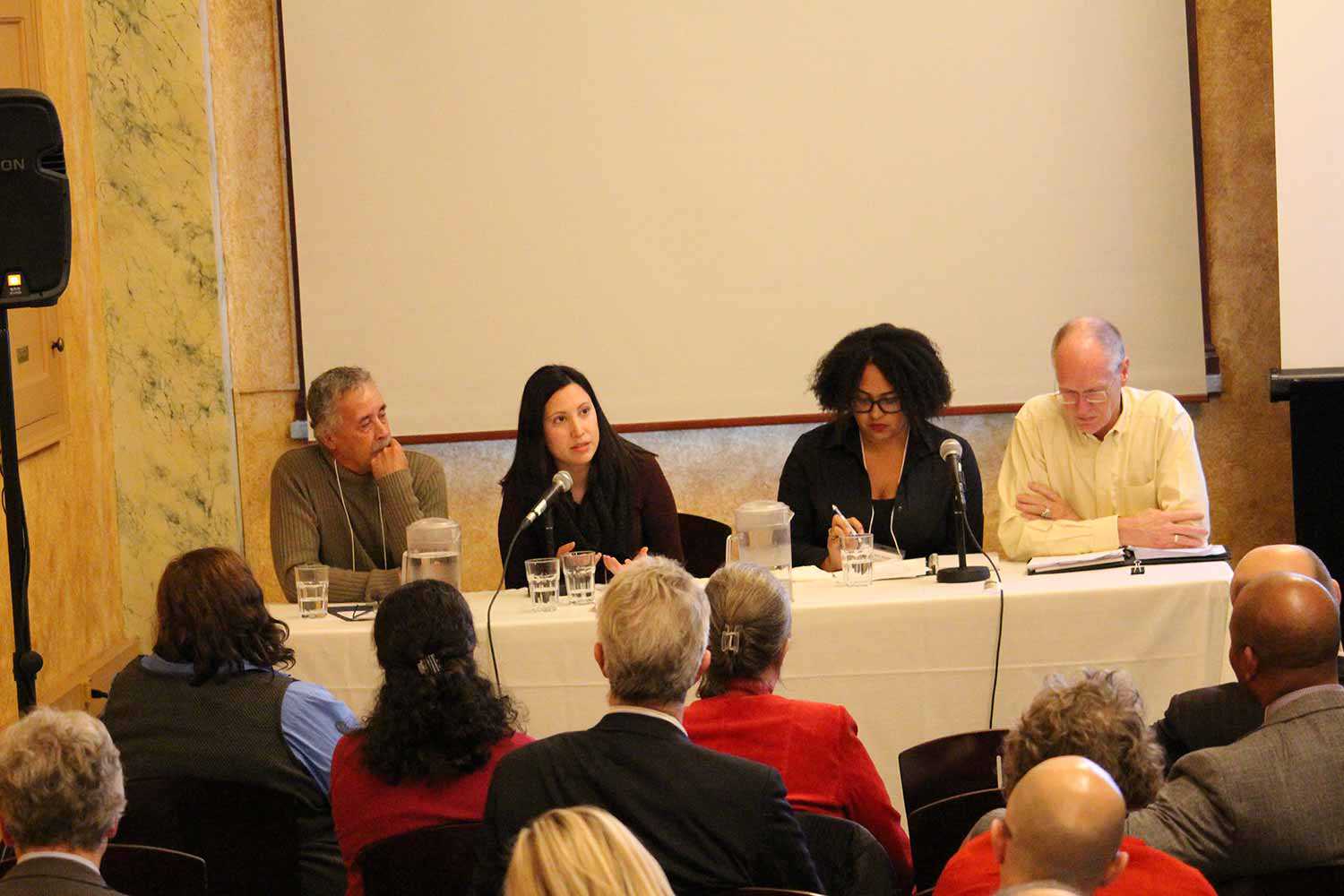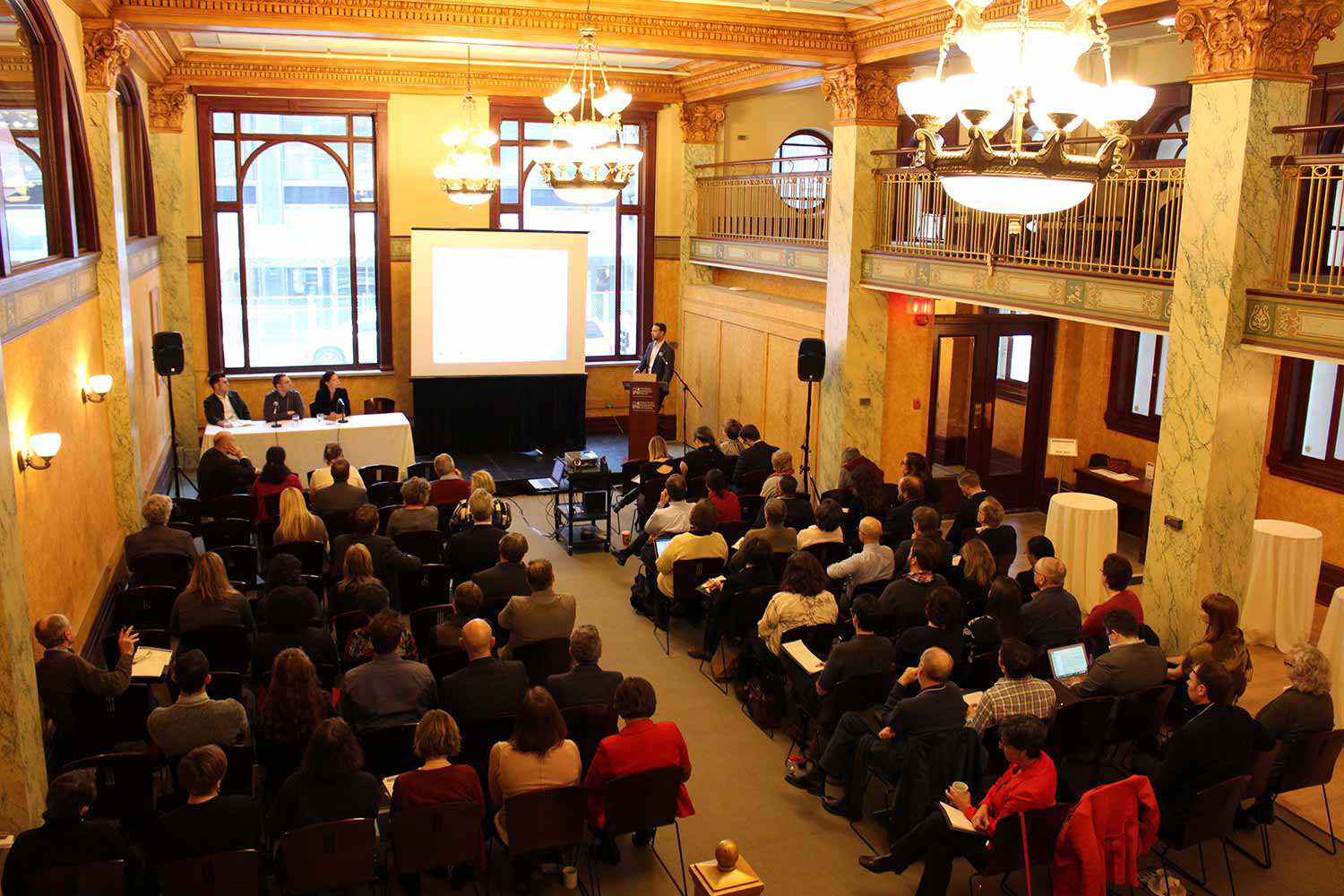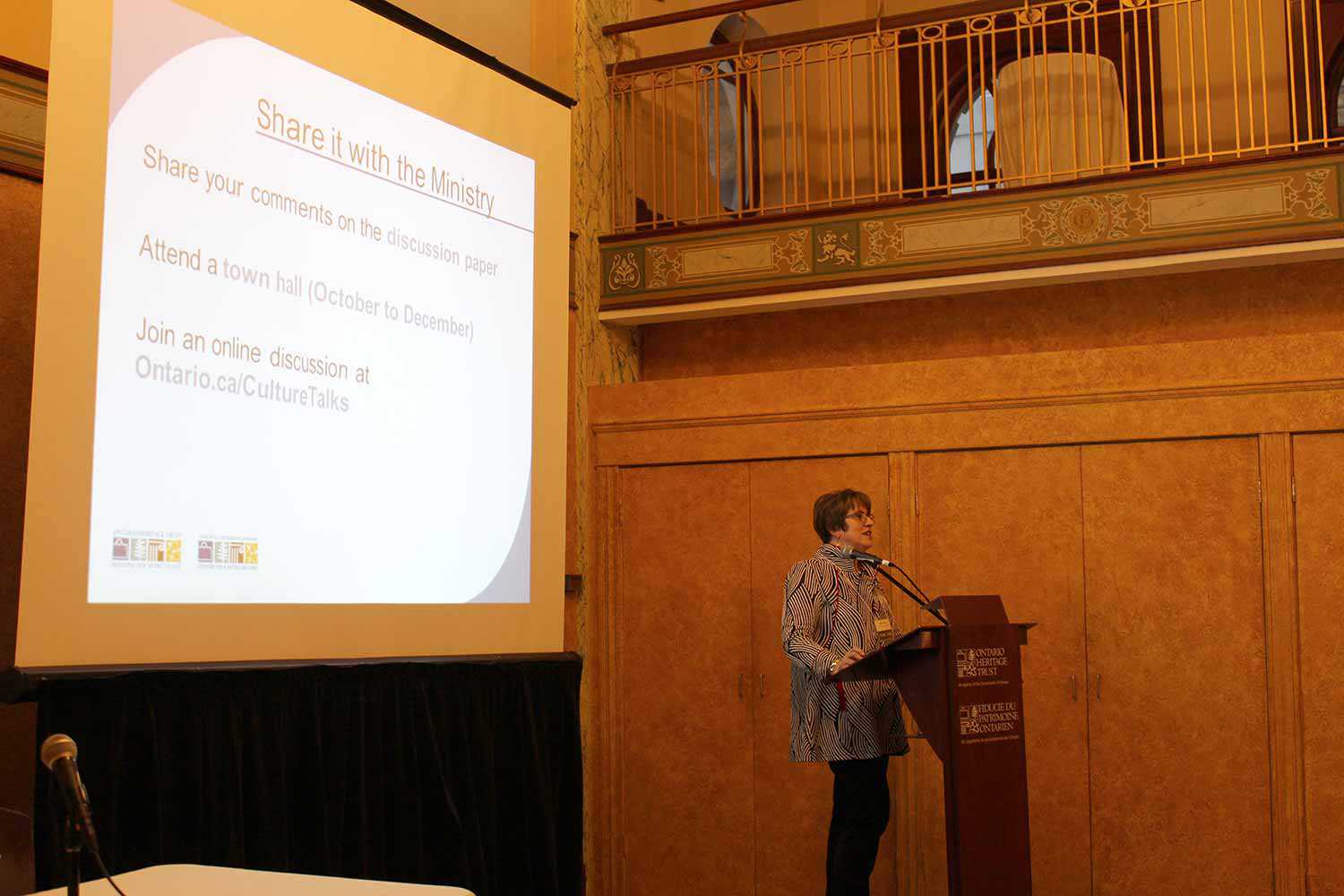Menu
Highlights from the Ontario Heritage Trust Cultural Heritage Symposium
Monday, November 23, 2015
Introduction
On Monday, November 23, 2015 the Ontario Heritage Trust held a one-day symposium to encourage discussion of, and inspire contributions to, Ontario’s Culture Strategy. Harvey McCue, Vice-Chair of the Ontario Heritage Trust Board of Directors welcomed participants. Beth Hanna, Chief Executive Officer of the Trust began the day with an overview of the breadth and scope of heritage, cultural and natural, tangible and intangible. Kevin Finnerty, Assistant Deputy Minister of the Ministry of Tourism, Culture and Sport’s Culture Division, spoke on behalf of the province and provided an update on the creation of Ontario’s first Culture Strategy.
The symposium explored five topics through panel presentations and discussion: Cultural landscapes, City building, Tangible heritage, How the public engages with heritage, and Conserving the intangibles. Panels were composed of professionals working within public, private and not-for-profit sectors, from a range of fields – including municipal heritage planning, museums and archives, education and research, architecture and urban design, media, archaeology and physical restoration. Participants included more than 100 sector leaders, colleagues, professionals and thinkers from equally diverse perspectives.
This report highlights ideas and best practices explored during the symposium. We believe that it provides useful feedback in support of a strong, vibrant, inclusive heritage sector that is well integrated into the culture of Ontario.
Agenda
8 a.m. – Coffee and registration
8:30 a.m. – Welcome – Harvey McCue, Vice-Chair, Ontario Heritage Trust Board of Directors; Introduction – Beth Hanna, Chief Executive Officer, Ontario Heritage Trust
8:45 a.m. Ontario’s Culture Strategy: An update – Kevin Finnerty, Assistant Deputy Minister, Culture Division, Ministry of Tourism, Culture and Sport
9 a.m. – Cultural landscapes – Panel presentations and discussion (Moderator: Mike Sawchuck, Town of Ajax; Panellists: Lisa Prosper, Centre for Cultural Landscapes, Willowbank | Matt Setzkorn, Ontario Farmland Trust | Philip Evans, ERA Architects Inc.)
10 a.m. – Break
10:30 a.m. – City building – Panel presentations and discussion (Moderator: George F. Dark, Urban Strategies Inc.; Panellists: Harold Madi, Urban Design, City of Toronto | Alex Speigel, Windmill Development Group | Matt Blackett, Spacing Magazine)
11:30 a.m. – Tangible heritage – Panel presentations and discussion (Moderator: David O’Hara, Fort York National Historic Site; Panellists: Dima Cook, FGMDA Architects | April Hawkins, Royal Ontario Museum | John Wilcox, Vitreous Glassworks)
12:30 p.m. – Lunch and networking
1:30 p.m. – How the public engages with heritage – Panel presentations and discussion (Moderator: Melony Ward, Canada’s History Magazine; Panellists: Rebecka Sheffield, Canadian Lesbian and Gay Archives (CLGA) | Annemarie Hagan, Peel Art Gallery, Museum and Archives (PAMA) | Karen Carter, Myseum of Toronto)
2:30 p.m. – Conserving the intangibles – Panel presentations and discussion (Moderator: David Rayside, Mark S. Bonham Centre for Sexual Diversity Studies, University of Toronto; Panellists: Blair Newby, Multicultural History Society of Ontario | Bryan Prince, Author | Janis Monture, Woodland Cultural Centre)
3:30 p.m. Concluding comments and wrap-up discussion
4 p.m. Adjournment
Highlights from the day
The public has an appetite for increased understanding and connection to their surroundings, and people are actively seeking opportunities to participate in their communities. David O’Hara shared an example of this excitement through his retelling of a recent archaeological discovery in the former 1833 Queen’s Wharf. The public was captivated as the story of uncovering the remains of a 50-foot-long hull from a double-masted ship unfolded, proving that public interest, appreciation and engagement with heritage is growing. Discussions throughout the day were rooted in the concept of legacy, in terms of the sense of history and place communicated through tangible evidence and intangible histories, but also in terms of the resiliency of communities, the built environment and ecological systems passed forward to the next generation.
Recognizing diversity and interconnectivity
Cultural heritage is manifested in environments, objects and narratives. Throughout the day, panellists and participants made reference to the notions of diversity and interconnectivity as being at the centre of cultural heritage. There was broad recognition that cultural heritage is an organic system of different components that interact with one another and are continually changing, and agreement that we should “look at the whole, rather than the sum of its parts.” Panellists recognized a shift toward what Bryan Prince referred to as a “diversity of focus,” expressed through definitions, interpretations, representations and approaches to cultural heritage.
The current definition of heritage has led to its formal consideration as a standalone sector but, in practice, heritage is a system of interrelated parts that span several different disciplines. Cultural heritage encompasses both tangible and intangible heritage, and interconnections between natural and human environments. As Dima Cook reflected, the physicality of a place or object brings stories to life, and the tangible can be an anchor in the face of changing intangible values, and in turn, tangible heritage is enriched through narrative and story. Participants emphasized that maintaining this connection can add value to the conservation of cultural landscapes, and city building, engagement and educational activities by deepening the public’s awareness, understanding, knowledge and experience of heritage.
In his introduction to the Cultural landscapes session, Mike Sawchuck stressed the value of considering natural and cultural elements in combination and reflected that there is little commentary on how to manage and conserve these complex environments. The notions of diversity and interconnectivity were reflected in how panellists and participants approach cultural landscapes – by looking at the “ecology of a place,” as Lisa Prosper aptly put it. An “ecological approach” to cultural landscapes recognizes that natural and cultural environments co-exist and interact with one another, and prioritizes “species” diversity in planning and conservation activities. Collectively, participants referred to the importance of multifaceted cultural landscape conservation approaches that incorporate past and present uses and users, including natural heritage elements and fauna, as well as built form and evidence of human interventions.
Several panellists observed that lack of a consistent, clear, inclusive definition results in misinformation, fear and resistance to conservation efforts. For instance, Cultural landscapes panellist Matt Setzkorn commented that many farmers fear cultural landscape theory and recognition as an additional burden of regulation, and are wary of its potential to restrict their businesses and livelihood.
Participant recommendations:
- Expand the definition of “heritage” to include natural and human environments, and tangible and intangible heritage with equal weighting, and ensure that this definition is applied throughout all provincial legislation, regulation and policy.
- Due to the reach of “heritage” and “culture,” broaden the scope of the Culture Strategy to other ministries beyond the Ministry of Culture, Tourism and Sport.
- Facilitate integration between different levels of government to support enforcement of legislation, regulation and policy for the conservation of cultural and natural, tangible and intangible heritage.
Panellists also called for a “diversity of focus” in how heritage is interpreted and represented. Ontario is a demographically diverse province, home to hundreds of distinct cultures and ethnic communities from across the globe with different experiences, knowledge and interpretations of their environment. A strong call was made for reflecting the diversity of Ontario’s communities in the interpretation and representation of heritage, and the methods used to engage the public in its shared heritage. The call includes expanding the typical definition of diversity beyond ethnicity to include other connection points, such as age or similar life experiences (e.g., the experience of political and civil unrest or war).
Blair Newby explained how the Multicultural History Society of Ontario (MHSO) actively works to share stories about the diverse range of cultures present in Ontario through its Strangers No More: Immigrant History and Multicultural Canada collection. MHSO’s collection includes over 2,525 oral history recordings and a substantial holding of explanatory and contextual materials that include interview transcripts, translations, biographical notes and historical photographs. Along with integrating a more inclusive sense of history into the definition of cultural heritage, discussion also focused on connecting the definition to the notion of resiliency, which includes cultural, economic, environmental and social considerations.
Examples to illustrate the connection between cultural heritage and resiliency were shared throughout the day. Philip Evans emphasized the economic role that cultural values can play in improving community resiliency through discussion of place-making activities in small communities. The economic and environmental benefits of revitalizing heritage buildings and sites through adaptive reuse were also discussed. Existing resources are given new life through reuse and, as John Wilcox suggested, conservation practitioners can incorporate sustainable practices, such as passive lighting, local materials and local skills and labour, as they conserve.
Increasing relevance through cultural reciprocity
The decision to conserve is rooted in value – the value that individuals and groups place on a landscape, object or story, and the value held for cultural heritage as an asset that can produce value. Participants acknowledge that value is inherently subjective – tied to personal understanding, experience, knowledge and interpretation – and it continually shifts over time for several reasons, including movement, appropriation and broader trends. Discussions continually circled back to the importance of maintaining a diversity of focus, to ensure that multifaceted interpretations of culture, heritage and value are considered.
Throughout the symposium, panellists and participants agreed that for heritage to have value, it has to be relevant to current society. Relevance was top of mind for panellists – for Harold Madi, “the human dimension of what occupies these buildings is fundamental.” Melony Ward spoke about how, in the face of intense competition for audience interest, the magazine industry has moved away from a top-down, one-way style of communication toward bottom-up, audience-led content development. Panellists agreed that increasing heritage relevancy for the public could allow the sector to shift its focus toward “preventative conservation,” and avoid reactive conservation activities or “firefighting.” Throughout the day, several examples of how panellists are establishing heritage’s relevancy were shared – such as by providing opportunities for cultural exchange, continually using heritage structures and sites, and increasing access to heritage.
Outreach activities are an important way to engage the public, but panellists such as Karen Carter also spoke about the importance of reciprocity to heritage conservation and the value that can be generated from facilitating exchange of knowledge, skills and resources. Annemarie Hagan shared a quote that captures the value of encouraging two-way dialogue: “Pursuing participatory models isn’t just about letting go of authority or expertise. It’s about opening up the institution to the possibilities of what visitors have to offer.” – Nina Simon, Participatory Design and the Future of Museums in Letting Go? Sharing Authority in a User-Generated World, 2011.
Providing multiple opportunities for the public to contribute actively to heritage fosters engagement and can increase understanding, awareness and value for cultural heritage. Cultural reciprocity plays a key role in citizenship by fostering a shared sense of place and history – participants discussed the importance of inviting newcomers to document their stories and add to Ontario’s cultural mosaic. The Myseum of Toronto’s Museum on the Move initiative takes story gathering activities on the road to reach audiences who may not otherwise engage with heritage in traditional settings. From the museum and archives perspective, two-way interpretation and dialogue helps to build collections by providing opportunities for individuals and communities to contribute their personal histories and perspectives on broader narratives. Facilitation for cultural exchange can also build networks and capacity in the cultural heritage sector. The Peel Art Gallery, Museum and Archives’ (PAMA) annual exhibition for Sikh Heritage Month is a shining example of the ways in which networks can be built in the cultural heritage sector as a result of cultural exchange. Annemarie Hagan explained that PAMA’s collaboration within the Sikh Foundation of Canada has strengthened ties between the Sikh community and the Region of Peel’s cultural heritage sector. She affirmed that the greatest connections happen when people are able to share their stories in their own voice.
Participant recommendations:
- Improve or create grant programs that support cultural exchange, and facilitate collaboration and partnerships.
Relevance also comes from giving heritage an active role in contemporary society through continual use. Panellists shared several examples of how they maintain relevance, such as the Ontario Farmland Trust’s protection and preservation of active farmland and agricultural, natural and cultural features. Philip Evans reflected on how heritage gains relevance through community building activities: community building as a cultural practice leverages cultural assets for a more livable society. ERA Architect’s small project leverages the cultural resources of small communities through adaptive reuse and community building activities to support their transition away from dependence on natural resource industries.
Organizations and individuals are also working diligently to provide accessible engagement and participation opportunities developed with consideration for individual characteristics, abilities and learning styles, conditions and experiences. Rebecka Sheffield spoke about the Canadian Lesbian and Gay Archives’ intentional decision to locate in the Jared Sessions House, a designated heritage property, to transform the archive into a community gathering place with a reading room, art gallery and meeting space.
Embracing creative approaches
Presentations and discussions encouraged adopting active public consultation and community engagement processes, and facilitating partnerships and collaboration to develop networks and connections between ministries, organizations and individuals working in the cultural heritage sector and the broader public. Panellists agreed that creative approaches have a wide range of benefits: they can enrich participatory opportunities, ensure that information is passed from generation to generation, increase the accessibility of cultural heritage and sector discussions, and break down barriers between related disciplines.
Overwhelmingly, panellists stressed that creative approaches emerge from knowing your audience, and are more impactful and richer when they come from the community. Strong emphasis was placed on the need for both top-down and bottom-up approaches to consultation, community engagement and opportunities for active participation. Enhanced consultation processes enable communities to engage in decision-making around cultural and natural heritage and can lead to conservation efforts that are inclusive of a diverse range of values. Inclusive conservation efforts can begin to weave a shared history that increases the relevance of heritage for the public and their engagement with, and ownership of, conservation outcomes.
Collaboration among the public, private and not-for-profit sectors, as well as individual community members, is an important part of successful conservation. Panellists and participants spoke about the power of actively building relationships and networks through fostering discussions and providing opportunities for connection, engaging in collaborations and uniting people with practice through place-making and community-building activities. In her presentation about how the Woodland Cultural Centre conserves intangible heritage, Janis Monture explained that Woodland supports collaboration by pairing youth with Elders to facilitate sharing of Indigenous knowledge, values, language and traditions.
Establishing formal partnerships can bring collaboration one step further by providing sustainable support for conservation and interpretation activities. Specific reference was made to the importance of partnerships with the private sector, which can encourage knowledge sharing and mobilization and efficient use of resources. Through intentional design and purchasing, the private sector also plays a central role in supporting the continuance of skills and traditional knowledge of heritage practitioners – who John Wilcox called “keepers of the fabric” – by incorporating traditional techniques into projects.
Participant recommendations:
Provide support for building the capacity of community members, local governments and private companies working within cultural and natural heritage conservation and interpretation.
The value of digitization for cultural heritage was also emphasized throughout the day. George Dark stated that “the digital revolution will become a mainstay for how we transfer culture.” Participants agreed that digitalization can be used as a tool for conservation, interpretation and presentation, facilitating connection and building collective awareness and understanding of cultural heritage.
Participants referenced digitization as a tool for preservation that can ensure the continuity of material records and provide opportunities to transform fragile intangible heritage into tangible heritage. Digitization was also identified as a way to provide support for the continued creation and documentation of heritage. It allows cultural heritage, specifically the intangible, to be shared in the voice of the creator, ensuring authenticity and limiting the subjectivity inherent to curation. Digitizing collections and archives creates resources that can be used by cultural producers as well. Technological innovations have increased access to cultural production. David Rayside spoke about the new wave of information that will need to be archived, and the challenge that this presents to conservators moving forward. As technology advances and cultural production increasingly involves digital media, expressions of culture become more ephemeral – presenting challenges to preservation efforts. So, while digital media and modes of transmission provide opportunities to conserve and improve access to cultural heritage, participants recognized that conservators need to be mindful of their impermanence and develop strategies and solutions to ensure the continuance of tangible and intangible heritage.
In terms of the “use” aspect of conservation, digital tools can increase the relevance of collections and engagement with cultural heritage by speaking to the audience through the mediums they use and interact with in their everyday lives. April Hawkins shared how the ROM is increasing engagement with archaeology by using Google Maps to show the original location of archaeological assets featured in their First Story Toronto exhibit. Their initiative was so successful that before the exhibit opened, the public map had over 26,000 visits. Presenting heritage on public digital platforms like Google Maps enables cultural heritage to be shared more broadly and with individuals who may not normally access institutional settings and heritage sites, such as marginalized and new communities. Digital tools can also enable the creation of tangible objects that the public interact with on a daily basis. Matt Blackett described how Spacing Magazine uses consumer products such as coasters, buttons and art prints to bring heritage into the home and to stimulate an emotive connection to the places that we interact with in our everyday lives.
Participant recommendations:
- Support provincewide cultural mapping that encompasses both public and privately-operated and -held museums and resources.
- Encourage the use of digital tools (such as downloadable apps and graphic production) to connect cultural assets and experiences to tourism deliverables and consumables.
Engagement activities facilitate learning in an informal setting, but cultural heritage can also be shared by adopting creative approaches in formal education. Panellists and participants called for strengthening links with the Ministry of Education to develop curriculum, capitalize on existing linkages and assets within and outside of the cultural heritage sector, and include a broader diversity of heritage in training, curriculum delivery and programs. John Wilcox suggested that a cohesive strategy for heritage conservation training could also be developed by bringing operators of conservation education programs – such as Willowbank and Algonquin College – together for a symposium to discuss their experiences and opportunities in the sector.
The energy generated by symposium presentations and discussion was palpable. Throughout the day, suggestions were made about mechanisms that could support sustainability in the heritage sector. Presentations and discussions focused around three overarching frameworks or systems that greatly influence the heritage sector: these being the funding, education and planning and taxation systems.
Participants spoke about existing funding programs, such as the Museum Operating Grant, and called for onerous application processes to be streamlined to facilitate access for organizations with less capacity. Panellists and participants also called for access to stable, annual funding opportunities that are not necessarily tied to specific events and celebrations, and are targeted to both the conservators and creators of culture. Beyond supporting operations and initiatives, funding programs were seen as a way to facilitate connections between heritage and related disciplines – for example, as Myseum of Toronto has done with its Intersections grant, incentives could be provided to encourage the use of collections in archives and museums by curators and cultural animators working primarily in the arts sector.
Support for active contribution to heritage extended to the topic of research and practice. Panellists and participants called for improved connections to active research networks embedded within post-secondary institutions and non-government organizations by providing support for communication, the dissemination of data and information, and the presentation and publication of ideas and projects. Symposium presentations and discussions also called for continual support for education in skilled trades specific to heritage conservation (e.g., glass conservation, heritage masonry, fine carpentry, etc.) and opportunities for skill development, including but not limited to apprenticeships, training and post-secondary education.
Panellists and participants made specific recommendations for how the planning framework and taxation system could be changed to better support conservation.
From Harold Madi’s perspective, the number one priority is shifting the taxation structure so that heritage buildings are not taxed based on their development potential. Panellists and participants supported Madi’s statement and specifically called for provincial powers to be used to address the disincentive for conservation created by the standard method of property valuation based on “highest-and-best-use.” To ensure that urban environments do not become monotonous landscapes due to the current property valuation formula, Alex Speigel encouraged the creation of tiered development charges in high-density areas to support a mixture of different scales and types of development and, as Speigel put it, to prevent “invasive species” from taking over an area.
Presentations and discussions called for the province, as well as individuals and organizations working in the heritage sector, to encourage conservation among private property owners by actively dispelling myths about the implications of heritage designations on property values and insurability. At the same time, panellists and participants called for providing incentives to private property owners for the conservation of heritage structures and sites, and landscape conservation and reclamation to support conservation efforts. They also stressed the importance of tying incentives to conservation measures to ensure that proposed conservation commitments are realized.
Beth Hanna concluded the day by inviting participants to share one thing they want to see reflected in the Culture Strategy. Participants shared the following ideas:
- Breaking down the silos within the culture sector. It’s not just about culture or arts or heritage, but about all three and more, and the connections between them.
- Culture goes beyond the Ministry of Tourism, Culture and Sport. All other ministries and agencies are part of realizing Ontario’s Culture Strategy.
- Increased consultation with the greater community to determine what they want and how they assign value.
- Genuine and authentic strategies to increase engagement with the non-connected public.
- Quantification of culture’s broad impact in terms of quality of life, economic costs and benefits, and in areas such as health care, industry, etc.
- A move toward a culture of conservation by flipping the burden of proof – groups and individuals that seek demolition and wish to exploit culture should be asked to disprove its value.
- Improved tools for successful stewardship that address a lack of industry experience with adaptive reuse at the structural and insurance level.
- Encouragement for education and curriculum delivery to include stories that are not commonly shared, including Indigenous histories.
- A call for a second round of funding for creating and realizing Municipal Cultural Plans, and for evaluation and updating of existing plans.
- Economic incentives alone may not ensure conservation. Tie incentives to fulfillment of conservation commitments.

